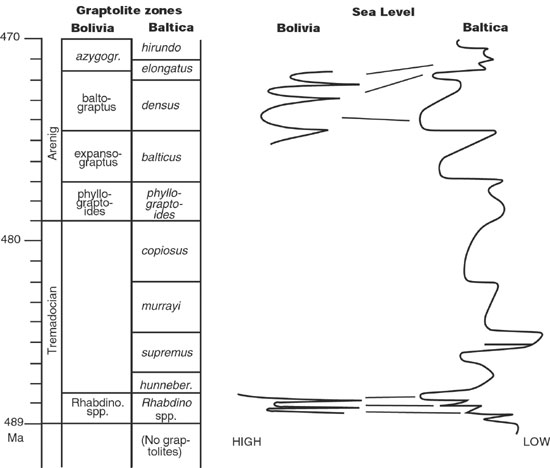
Comparing Early Ordovician sea–level changes in southern Bolivia and Baltica: a siliciclastic shelf versus a carbonate ramp
Sven Egenhoff1 and Arne Thorshøj Nielsen2
1 Technische Universität Bergakademie Freiberg, Institut für Geologie, Bernhard–von–Cotta–Str. 2, D–09599 Freiberg, Germany. E–mail: Sven.Egenhoff@geo.tu-freiberg.de
2 Geological Museum, University of Copenhagen, Oester Voldgade 5–7, DK–1350 Kbh K, Denmark.
Key words: Bolivia. Baltica. Sea–level changes. Carbonate ramp. Siliciclastic shelf.
Introduction
The reconstruction of Ordovician sea–level changes has been attempted for various continents with considerable success: Ross and Ross (1992) compiled the Northern American data, Nielsen (1992a, in press) as well as Dronov and Holmer (2002) summarized the Baltoscandian fluctuations, and Chen (1991) and Su (1999) published results from China. However, few studies have compared biostratigraphically well–dated successions from two different continents to test a possible eustatic origin of the cycles (Nielsen, 1992b). In this report, the sea–level fluctuations on two shallow–marine Lower Ordovician shelves – the Bolivian and the Scandinavian – are correlated. The sedimentary environments of the two candidates could not be more different: Scandinavia formed part of a carbonate ramp with very slow rates of sedimentation, whereas the Bolivian shelf was characterized by siliciclastics and an extremely high sediment input (Egenhoff, 2000). However, the graptolite faunas of both areas are similar and allow a biostratigraphically exact correlation despite the enormous lithological differences. The Scandinavian graptolite subdivision is summarized in Maletz et al. (1996) and figured in Nielsen (in press), the Bolivian data are compiled in Maletz and Egenhoff (2001) and Egenhoff et al.s (submitted).
Southern Bolivia
The southern Bolivian shelf is characterized by two sequences in a delta complex between the basal Ordovician unconformity and the middle Rhabdinopora flabelliformis Biozone, overlain by a pronounced transgression that drowned the shelf. The overlying Tremadoc and lowermost Arenig units were deposited on a submarine ramp and do not record sea–level changes (Egenhoff 2000). Again in the lower to middle Arenig, three more sequences are well developed in a prograding delta succession. A pronounced lowstand occurred in the upper Expansograptus holmi Biozone (corresponding to the upper Didymograptus balticus Biozone in Scandinavia), followed by an abrupt deepening during the transgression. Most of the transgressive and highstand sediments form part of the lower Baltograptus minutus Biozone (corresponds to the lower Pseudophyllograptus densus Biozone of Scandinavia). The succeeding sea–level lowering occurred during the upper Baltograptus minutus Biozone. The youngest sequence cropping out on the southern Bolivian shelf correlates with the uppermost Baltograptus minutus Biozone, and this interval would be equivalent to the lower Pseudophyllograptus angustifolius elongatus Biozone of Scandinavia.
Scandinavia
Despite the fact that the Scandinavian succession shows a more complete record of sea–level changes, all the Bolivian fluctuations can also be detected in the Scandinavian carbonate ramp succession. Within the lower and middle Rhabdinopora flabelliformis Biozone, two sequences and an overlying pronounced transgressive surface are present, correlating well with the two Bolivian Tremadoc deltaic sequences. The three sequences in the Arenig also show an excellent fit: the Scandinavian succession indicates a pronounced lowstand in the upper Didymograptus balticus Biozone, too, as well as one more fluctuation in the Pseudophyllograptus densus Biozone and another in the lower Pseudophyllograptus angustifolius elongatus Biozone.

Figure 1. Comparison between Lower Ordovician sea level curves of Bolivia and Baltica, based on Egenhoff et al. (submitted) and Nielsen (in press).
Conclusions
This first approach to compare the Bolivian with the Scandinavian successions shows a remarkably good overall agreement between both basins. It should also be noted that the biostratigraphic base for the correlation is excellent and therefore the relative timing of the sea level changes is well defined. As the sedimentary environments as well as the tectonic situations of both study areas are significantly different, we conclude that the sea–level fluctuations in the investigated sequences seem to be largely eustatic in origin.
References
Chen, J., 1991. Bathymetric biosignals and Ordovician chronology of eustatic variations. In: Barnes, C.R. and Williams, S.H. (Eds.): Advances in Ordovician Geology. Geological Survey of Canada Paper 90–9: 299–312.
Dronov, A., Holmer, L. 2002. Ordovician Sea–Level Curve: Baltoscandian View. In: The Fifth Baltic Stratigraphical Conference "Basin stratigraphy – Modern Methods and Problems", Lithuania: Extended Abstracts – Vilnius: 33–35.
Egenhoff, S.O. 2000. Sedimentologie und Beckenentwicklung im Ordovizium in Südbolivien. Berliner Geowissenschaftliche Abhandlungen, A207: 1–173
Egenhoff, S., Maletz, J. and Erdtmann, B.–D. (submitted to Geological Magazine): Lower Ordovician graptolite biozonation and lithofacies of southern Bolivia: relevance for palaeogeographic interpretations.
Maletz, J. and Egenhoff, S. 2001. Late Tremadoc to early Arenig graptolite faunas of southern Bolivia and their implications for a worldwide biozonation. Lethaia, 34: 47–62.
Nielsen, A.T. 1992a. Ecostratigraphy and the recognition of Arenigian (Early Ordovician) sea–level changes. In: Webby, B.D. and Laurie, J.R. (Eds.), Global perspectives on Ordovician Geology, Balkema, Rotterdam: 355–366.
Nielsen, A.T. 1992b. Intercontinental correlation of the Arenigian (Early Ordovician) based on sequence and ecostratigraphy. In: Webby, B.D. and Laurie, J.R. (Eds.), Global perspectives on Ordovician Geology, Balkema, Rotterdam: 367–379.
Nielsen, A.T. In press. Sea–level Changes – a Baltoscandian Perspective. In: Webby, B., Droser, M, Paris, F. and Percival, I. (Eds.): "The Great Ordovician Biodiversification Event", Part II. Conspectus of the Ordovician world. Columbia University Press volume.
Ross, J.R.P. and Ross, C.A. 1992. Ordovician sea–level fluctuations. In: Webby, B.D. and Laurie, J.R. (Eds.), Global perspectives on Ordovician Geology, Balkema, Rotterdam: 327–335.
Su, W. 1999. The SMST (shelf margin wedge systems tract) subjacent to the Ordovician–Silurian boundary and its potential on Ordovician chronostratigraphy. In: Kraft, P. and Fatka, O. (Eds.), Quo vadis Ordovician? Acta Universitatis Carolinae, Geologica, 43 (1/2): 183–186.
Received: February 15, 2003
Accepted: June 15, 2003